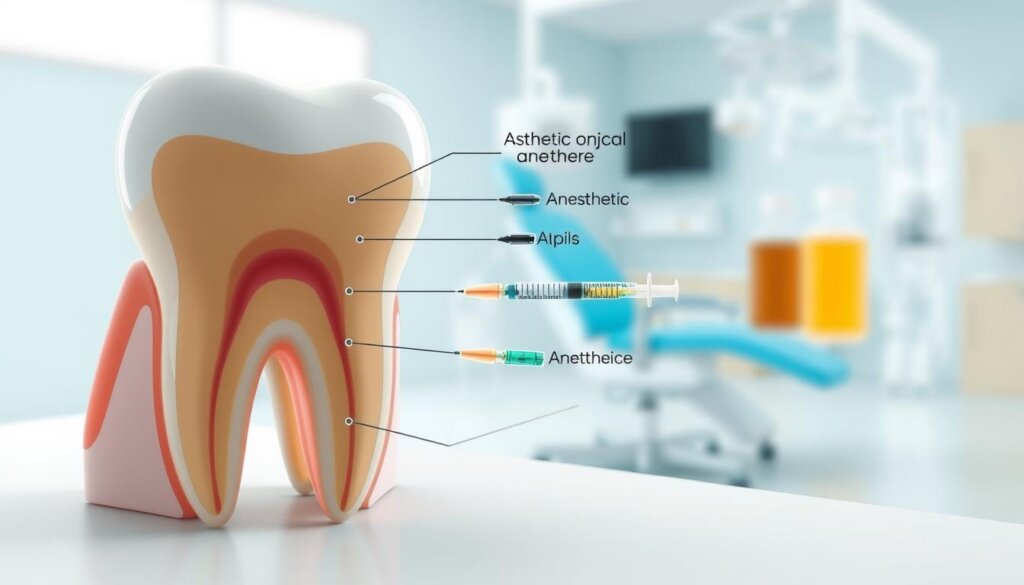Root Canal Pain: Does It Hurt During the Procedure?
Every year, 15 million root canal treatments happen in the United States. This fact surprises many who wonder if it’s as painful as they’ve heard. The American Association of Endodontists reports this number.
Does a root canal hurt during the procedure? Modern dentistry uses new methods and local anesthetics to make patients comfortable. Our knowledge of dental pulp, nerve pain, and regenerative medicine has grown. So, the pain feared in the past is much less today.
Some think root canal therapy is very painful. But, experts say the pain is usually mild. It’s often like the feeling of getting a routine filling. This article explains how technology and anesthesia options answer the question: Does a root canal hurt during the procedure?
Key Takeaways
- Root canals rank among the most common dental treatments in the United States.
- Local anesthetics have minimized discomfort during the procedure.
- Advanced research in regenerative medicine supports modern techniques.
- Comparable pain relief to a simple filling is often reported by patients.
- Fear surrounding root canals is linked to outdated misconceptions.
Understanding Root Canals and Their Purpose
Teeth with deep infections are at risk when their pulp is damaged. Endodontic procedures can save these teeth and prevent more problems. Is it wise to ignore root canal pain when early action can protect the tooth?
What is a Root Canal?
A root canal treats the inner pulp of a tooth. Dentists remove the inflamed tissue, clean, and seal the canals. This method protects the tooth and keeps it in place.
Why Are Root Canals Necessary?
Deep decay or trauma can let bacteria into the pulp, causing pain. Experts from the American Dental Association say early treatment is key. It prevents tooth loss, saves money, and keeps your mouth healthy.
Common Symptoms Indicating a Root Canal
- Persistent toothache or throbbing sensation
- Heightened sensitivity to hot or cold
- Swollen gums near the infected area
These signs often mean you might need a root canal. Quick action and professional care can stop more problems and keep your smile bright.
The Root Canal Procedure Walkthrough
Keeping patients comfortable is key in any treatment. This careful approach aims to reduce pain during the root canal. Building trust from the start helps patients feel at ease.
Initial Consultation and Diagnosis
A thorough check-up is the first step. It uses X-rays and clinical tests to find the problem. This helps create a treatment plan that works.
Preparing for the Procedure
Every patient is different. Before starting, their medical history and any dental fears are considered. This ensures the right anesthesia is used to manage pain.
The Step-by-Step Process of a Root Canal
The dentist starts by numbing the tooth. Then, they remove the damaged pulp through a small opening. Next, they clean and seal the canals to prevent infection. This step helps keep the tooth healthy for a long time.
| Stage | Key Action |
|---|---|
| 1. Assessment | X-rays confirm the exact location of infection |
| 2. Anesthesia | Ensures a comfortable experience |
| 3. Cleaning | Removal of infected pulp and disinfection |
| 4. Sealing | Canals are filled to prevent future issues |
Do You Feel Pain During a Root Canal?
Many worry about pain during a root canal. Today’s methods and medicines make it mostly pain-free. The goal is to get rid of infection and save the tooth.
Anesthetic Options Used
Dentists use local anesthesia to numb the area. They also offer sedation to help with anxiety. This makes sure you won’t feel much pain.
For those who want to relax more, there are options like oral or IV sedation.
What to Expect During the Procedure
The dentist removes infected tissue and shapes the canals. Then, the tooth is sealed to prevent future problems. People usually feel pressure, not sharp pain, because of the anesthetic.
Once the inflamed tissue is gone and the area is clean, the pain often goes away.
Individual Pain Tolerance Levels
Everyone feels pain differently. That’s why getting care that fits you is key. Some need a little help, while others need more.
Modern dentistry makes sure you’re comfortable every step of the way. Dentists work with you to make sure you’re okay.
| Anesthetic Choice | Key Benefit |
|---|---|
| Local Injections | Targets nerves to reduce or eliminate pain |
| Conscious Sedation | Lowers stress and eases mild discomfort |
| General Anesthesia | Soothing option for severe dental anxiety |
Factors Influencing Pain Perception
Everyone feels pain differently because of their biology and emotions. Some people feel a lot of pain, while others barely notice it. The pain from a root canal can vary a lot, depending on how you feel and the health of your tooth.
Doctors try to understand these differences to help each patient better. By sharing what they know and giving practical advice, they build trust. This helps patients feel better and get the care they need for a long time.
Anxiety and Fear of Dental Procedures
Being nervous can make you feel pain more. Stress hormones can make you feel more pain than you should. Techniques to relax and talking openly can help a lot.
Previous Dental Experiences
Bad memories from dental visits can make you more scared now. Fears and pain from before can make you feel uneasy. But, being kind and explaining things can help you feel better.
Tooth Condition and Sensitivity
Bad cavities, infections, or cracks can make pain worse. Tissues that are not healthy can hurt more when touched. Getting help early and following advice can make things better.
Managing Pain Before and During the Procedure
Patients often worry about feeling pain during care. A good plan for managing root canal pain includes medicine and relaxation. Working together with your dentist can make things easier and less stressful.
Many people use over-the-counter pain relievers or short-term prescriptions. Breathing exercises can also help. Feeling ready can make you feel less anxious and more hopeful.
Pain Management Strategies
The dentist might recommend:
- Anti-inflammatory medication to reduce swelling
- Local anesthetics for more comfort
- Short breaks for rest
Discussing Concerns with Your Dentist
Talking openly helps find the best solutions. Sedation dentistry is an option for those who are very anxious. Sharing your past experiences helps your dentist tailor the treatment and build trust.
Calming Techniques to Reduce Anxiety
Use simple ways to relax and focus on managing root canal pain. Try visualization and listening to soothing music. Counting your breaths can also help you stay calm.
| Technique | Benefit |
|---|---|
| Guided Meditation | Distracts the mind from pain signals |
| Positive Affirmations | Builds confidence and reassurance |
| Steady Breathing | Helps maintain a tranquil mindset |
Post-Procedure Pain: What to Expect
Mild aches are common after the procedure ends. Many find that tender gum tissue signals normal healing. Is it necessary to worry over slight swelling? Careful monitoring helps determine if symptoms fall within expected limits.
Our experts note that root canal therapy discomfort usually subsides within a few days. Yet, patients occasionally feel occasional throbbing that may last longer. Paying attention to changes can prevent larger complications.
Typical Recovery Timeline
Initial soreness often decreases steadily, allowing daily activities to continue with minimal interference. Over-the-counter medication may assist when needed. Complete healing times can vary, but most individuals experience significant relief within one week.
Differences Between Pain and Discomfort
Sharp or escalating agony points to a more serious issue, whereas pressure or tenderness may simply indicate natural healing. Root canal therapy discomfort often manifests as mild sensitivity, not unmanageable pain.
When to Seek Help After a Root Canal
Severe throbbing that grows worse deserves immediate professional assessment. Contacting a dentist is wise if fever appears or if bleeding or swelling intensifies beyond the first few days.
| Timeframe | Symptoms | Recommended Action |
|---|---|---|
| 1–2 Days | Mild soreness | Use OTC pain relievers |
| 3–5 Days | Decreasing sensitivity | Maintain gentle oral hygiene |
| After 1 Week | Minimal discomfort | Call dentist if severe pain returns |
Comparing Pain Levels: Root Canals vs. Other Dental Procedures
Many people worry when choosing between dental options. Experts say removing infected pulp can bring a lot of relief. Following root canal pain management tips can help ease recovery.
Some think extractions or implants are easier, but studies show root canals might be less painful. Keeping your natural tooth is often the best choice, as most dentists agree.
Root Canals vs. Tooth Extractions
Extraction means losing the tooth, which might need to be replaced later. Root canals, on the other hand, keep the tooth and bone healthy. This can prevent problems with nearby teeth.
Root Canals vs. Dental Implants
Getting an implant is a surgery that might need extra bone work. Root canals target the infection directly, avoiding more complex procedures. The choice depends on the tooth’s health and your dental goals.
Patient Reviews and Experiences
Many patients report less pain after the infected tissue is gone. They thank root canal pain management tips for helping with aftercare. Dentists stress the importance of talking openly about any ongoing pain.
Here’s a table showing the main differences:
| Procedure | Tooth Preservation | Common Discomfort Level | Recovery Duration |
|---|---|---|---|
| Root Canal | Yes | Mild to Moderate | Several Days |
| Tooth Extraction | No | Moderate | Up to a Week |
| Dental Implant | No | Moderate to High | Several Weeks |
Addressing Common Myths About Root Canal Pain
Root canal procedures are often seen as very painful. Many wonder if the whole process is a nightmare of pain. But, modern techniques aim to make the process as comfortable as possible, both during and after.
Myth 1: Root Canals Are Always Painful
Some think root canals always lead to toothaches. But, skilled endodontists use the latest in anesthesia and precise methods to lessen pain. Many patients find the pain they feared is much less than they thought.
Myth 2: All Dentists Have the Same Skills
Dentists vary in their training and experience. A dentist with deep endodontic knowledge can improve results and healing time. This expertise leads to better pain relief through personalized care.
Myth 3: Recovery Is Prolonged And Painful
Recovery usually means just a bit of soreness that goes away in a few days. People can get back to their usual activities sooner than they think. It’s important to stay in touch with your dentist for ongoing comfort.
| Myth | Reality |
|---|---|
| Always Painful | Discomfort is often brief or minimal |
| All Dentists Equal | Endodontic specialists bring refined training |
| Prolonged Recovery | Healing usually progresses swiftly with proper care |
Preparing for Your Root Canal Appointment
Being prepared can make you feel more at ease and build trust with your dentist. Talking openly about pain during a root canal helps everyone. It makes the experience better for you.
“Confidence grows when patients understand their upcoming procedure and voice their questions,” states an article from the Journal of Endodontics.
Questions to Ask Your Dentist
Ask about anesthesia, possible pain, and how long it will take to recover. Many offices give written instructions to help. Here’s a quick list:
- Which anesthesia options are offered?
- What steps minimize stress during treatment?
- Are there special aftercare tips for faster healing?
Necessary Preparations Before Your Visit
Eat light meals and wear comfy clothes. Some people write down their symptoms and past experiences. This helps the dentist tailor pain management for you.
Importance of Previous Health History
Tell your dentist about any health issues, allergies, or past treatments. This info helps the dentist choose the right medication. Being open ensures a safer and more comfortable experience.
Aftercare Tips for a Smooth Recovery
Patients can take simple steps to protect their teeth and gums. These steps help with a smooth recovery and reduce pain. Keeping up with oral hygiene and diet is key to faster healing.
Recommended Post-Procedure Practices
Start with gentle oral care. Use a soft-bristled brush to avoid irritating the area. Drinking plenty of water helps with healing. Applying a cold compress to the jaw can help with swelling.
Follow your doctor’s advice on antibiotics or pain meds. This ensures you stay comfortable.
Foods to Avoid After a Root Canal
Stay away from hard, sticky, or very hot foods. They can irritate your gums. Opt for warm soups, mashed veggies, and soft proteins instead. They provide nutrients without harming your tooth.
Once your tooth feels better, you can start eating firmer foods again.
Pain Management Solutions at Home
For mild pain, try over-the-counter pain relievers and mouthwashes. If needed, your doctor might suggest stronger pain meds. Getting enough rest and managing stress also helps with healing.
The Importance of Follow-Up Care
Visiting the dentist after a root canal is key to healing and avoiding complications. If the tooth’s seal breaks, infection can return. A good plan and clean teeth help keep the tooth healthy for a long time.
Scheduling Follow-Up Appointments
Going back to the dentist soon lets them check on the tooth. They make sure it’s stable and that any fillings are in good shape. It’s best to plan these visits with your dentist to keep track of how you’re doing.
Monitoring for Complications
Seeing a dentist early can stop problems like swelling or pain from getting worse. Small issues can grow without you noticing, so regular check-ups are important. They also help keep the gums around the tooth healthy.
The Role of Routine Dental Care
Regular cleanings and exams help your tooth last longer. These visits help control plaque and check how your bite is doing. Along with brushing every day, they keep your mouth healthy and prevent more problems.
- Keep track of any unusual sensations
- Stay consistent with professional cleanings
- Practice proper brushing and flossing
| Timeframe | Action | Benefit |
|---|---|---|
| 1-2 Weeks Post-Procedure | Initial Follow-Up | Verify tooth stability |
| Every 6 Months | Routine Exams | Track ongoing oral health |
| As Needed | Specialized Consultation | Address emerging concerns |
Understanding Anesthesia Options
Dental treatments are better when patients feel relaxed. Anesthesia helps by numbing areas and soothing nerves. New tech and methods make it safer and more reliable.
Local Anesthesia: What to Expect
Local injections numb a specific area. Dentists may use a mild gel first. This makes the injection almost painless and keeps you awake.
Sedation Dentistry for Anxious Patients
Some people need more relaxation. They might choose oral sedatives or IV sedation. The American Dental Association says sedation helps with stress and anxiety during dental work.
Pain-Free Techniques in Modern Dentistry
New tools and methods make dental care more comfortable. Tools like computer-assisted anesthetic delivery and gentle injection techniques are precise. These advancements build trust and make complex treatments easier.
| Anesthesia Type | Primary Benefit | Consideration |
|---|---|---|
| Local Injection | Targeted Numbing | Minimal Systemic Impact |
| Sedation (Oral/IV) | Reduced Anxiety | Closer Monitoring Needed |
| Computer-Assisted Delivery | Precise Dosage | Equipment Availability |
Benefits of Root Canals Over Alternatives
Dental experts often recommend root canals to save the original tooth. This method keeps normal chewing function, protects gums, and prevents extraction problems. It’s a popular choice for those who want a stable, natural look.
Some people choose root canals for these reasons:
- Maintaining natural bite alignment
- Reducing the likelihood of bone resorption
- Supporting normal speaking and chewing
Preserving Natural Teeth
Keeping the tooth structure intact helps the jawbone stay healthy. The American Dental Association says a healthy root keeps teeth stable. This leads to better comfort and harmony in daily life.
Cost Comparison with Alternative Treatments
Implants or extractions often need more procedures. Root canals save time and money. They require fewer visits and keep the mouth healthy, making them a cost-effective option.
Long-Term Oral Health Advantages
Stable teeth make oral hygiene easier. People often face fewer problems and feel more confident. This approach aims to keep the natural tooth for better longevity and satisfaction.
Testimonials: Real Experiences
Many people share stories of how modern dentistry and patient care come together. They often arrive worried, but find the root canal more comfortable than expected. The Mayo Clinic’s research shows that new techniques make this treatment less painful.
Patient Stories About Root Canal Procedures
One patient had a quick recovery, getting back to meals and work fast. Another praised their endodontist’s clear communication. The American Dental Association also collects feedback, highlighting the impact of clear explanations and caring treatment.
Common Reactions and Feelings
Some patients were nervous before their appointment, fearing a lot of pain. But, they found the procedure felt like a simple filling. Dentists stress the need for open talks to keep patients calm throughout the process.
Lessons Learned from First-Time Patients
Many stress the importance of picking a skilled dentist. They suggest a few key steps:
- Ask detailed questions about anesthetic methods
- Trust recommended aftercare instructions
- Stay informed about every stage of the procedure
These tips help make endodontic care more positive for everyone.
Finding the Right Dentist for Your Root Canal
Patients feel better when they trust their dentist. Choosing the right one makes treatment smoother and less stressful.
How to Choose a Qualified Provider
Look for a dentist or endodontist who is board certified. This means they’ve met high standards. Being part of professional groups, like the American Association of Endodontists, shows they’re up-to-date.
Those who keep learning about new methods are committed to doing their best.
Checking Credentials and Reviews
Good reviews from patients can give you confidence. Online, you can read about their bedside manner and results.
A dentist with many positive reviews is likely to make patients happy. Professional ratings can also confirm their skill.
Importance of a Comfortable Environment
A friendly staff and a calm clinic make a big difference. Nice decor and thoughtful design help too.
Many top practices focus on caring for each patient personally. This makes the root canal process less scary.
Common Questions About Root Canals
Many people wonder how long root canals take, what to eat safely, and how they last. Dental experts say they are reliable, making people more confident in keeping their teeth.
Here are quick answers to the most common questions.
How Long Does the Procedure Usually Take?
A typical root canal takes 30 to 60 minutes. But, if it’s more complicated, it might take longer than 90 minutes. Dentists use special tools to work quickly and accurately.
Can I Eat After a Root Canal?
It’s best to eat soft foods right after. Once the numbness wears off and the area feels better, you can go back to regular food. Eating well helps your body heal from the procedure.
How Effective Are Root Canals in the Long Run?
Research by the American Association of Endodontists shows they work well. Many teeth stay healthy for years. Keeping your teeth clean, going for check-ups, and taking care of your mouth are key to long-term success.
| Complexity | Duration Range | Remarks |
|---|---|---|
| Simple Case | 30–60 minutes | Routine cleansing and sealing |
| Complex Case | 90+ minutes | Multiple canals or infection |
Conclusion: The Reality of Pain During Root Canals
Root canal therapy is usually safe. Modern technology and anesthesia help reduce pain. Dentists focus on making patients comfortable for a better experience and health.
Key Takeaways About Root Canal Pain
Pain from root canals is short and controlled with anesthetics. The goal is to remove infected tissue. This prevents abscesses and saves teeth, keeping them healthy for longer.
Encouraging Patients to Seek Treatment
Ignoring infections can harm more than just teeth. It can affect your health and lead to costly problems. Getting root canal treatment early helps you enjoy life without pain.
Final Thoughts on Dental Health and Care
Working with a skilled dentist is key. Knowing your options and talking openly helps fight infection and pain. Root canal therapy is a strong way to keep your smile.









